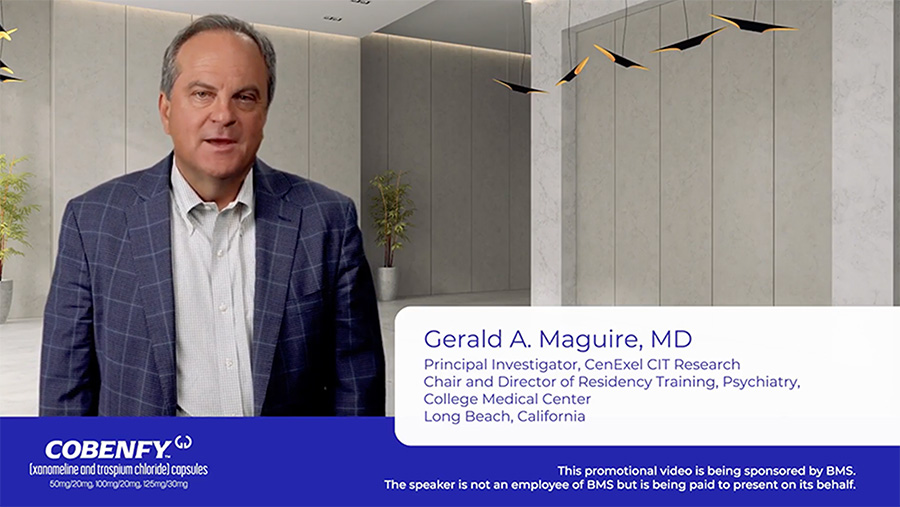Watch as experts share their perspectives on COBENFY.

Doctors Jelena Kunovac and Gerald Maguire detail the efficacy and safety profile, Doctor Gus Alva explores the mechanism of action, and Nurse Practitioner Hara Oyedeji explains how to get patients started
Your peers review the efficacy and safety profile of COBENFY across both short-and long-term trials; and practical steps to help get your patients started on COBENFY.

Short- and Long-Term Efficacy Data with COBENFY
Dr Gerald Maguire and Dr Jelena Kunovac review the efficacy of COBENFY that was assessed across symptom domains in short- and long-term trials in adult schizophrenia patients.
Peers featured in this video:
Dr Gerald Maguire, Principal Investigator at CenExel CIT Research and Chair and Director of Residency Training in Psychiatry at College Medical Center in Long Beach, California
Dr Jelena Kunovac, Cofounder and CEO of Redbird Research in Las Vegas, Nevada

Safety and Tolerability Profile of COBENFY
Dr Jelena Kunovac and Dr Gerald Maguire review the safety and tolerability profile, which was evaluated in over 1,250 patients across 5 clinical trials.1
Peers featured in this video:
Dr Jelena Kunovac, Cofounder and CEO of Redbird Research in Las Vegas, Nevada
Dr Gerald Maguire, Principal Investigator at CenExel CIT Research and Chair and Director of Residency Training in Psychiatry at College Medical Center in Long Beach, California

Have these peers' perspectives convinced you to start COBENFY?
Request a COBENFY representative or samples through our chatbot

Getting Patients Started on COBENFY
Nurse Practitioner Hara Oyedeji shares insights on starting COBENFY in your patients. Topics include dose titration and clinical considerations, such as recommended monitoring and relevant drug-drug interactions.
Peer featured in this video:
Hara Oyedeji, Nurse Practitioner at Fortitude Behavioral Health in Baltimore, Maryland

Learn How COBENFY, a First in Class M1/M4 Muscarinic Agonist, is thought to work2-5
Dr Gus Alva explains the mechanism of COBENFY, a first-in-class M1/M4 muscarinic agonist for the treatment of schizophrenia. COBENFY is a unique combination of xanomeline (M1M4 muscarinic agonist) and trospium chloride (muscarinic antagonist). Xanomeline is thought to work by selectively* activating M, and M, receptors. Although the mechanism of xanomeline in the treatment of schizophrenia is unclear, it is thought to work by selectively activating M, and M, receptors in the CNS. This activation is believed to help decrease dopamine in the CNS. Importantly, COBENFY does not bind to dopamine D receptors.2-5
Trospium chloride is thought to help limit muscarinic activation in the in the periphery.2
Peer featured in this video:
Dr Gus Alva, Assistant Professor in the Department of Neuroscience at the University of California, Riverside
See efficacy assessed across domains†‡
Start your patients on COBENFY
| † | Two randomized, double-blind, placebo-controlled, phase 3 studies assessed the safety and efficacy (change in PANSS total score from baseline at Week 5) of COBENFY—EMERGENT-2 (N=252) and EMERGENT-3 (N=256).3,7 See additional study design details. |
| ‡ | EMERGENT-2 and EMERGENT-3 trial results evaluating change in PANSS total score from baseline at 5 weeks vs placebo (EMERGENT-2: -21.2 vs -11.6, P<0.0001; EMERGENT-3: -20.6 vs -12.2, P<0.001). Change from baseline at Week 5 in PANSS positive subscale score was also assessed as a secondary end point and achieved statistical significance vs placebo (EMERGENT-2: -6.8 vs -3.9, P<0.0001, EMERGENT-3: -7.1 vs -3.6, P<0.001).3,7 |
| PANSS=Positive and Negative Syndrome Scale. |
References:
- Data on file. Karuna Therapeutics, Inc., a Bristol Myers Squibb company; Boston, MA.
- COBENFY. Prescribing Information. Bristol-Myers Squibb Company; 2024.
- Kaul I, Sawchak S, Walling DP, et al. Efficacy and safety of xanomeline-trospium chloride in schizophrenia: a randomized clinical trial. JAMA Psychiatry. 2024;81(8):749-756.
- Paul SM, Yohn SE, Popiolek M, Miller AC, Felder CC. Muscarinic acetylcholine receptor agonists as novel treatments for schizophrenia. Am J Psychiatry. 2022;179(9):611-627.
- Nucifora FC Jr, Mihaljevic M, Lee BJ, Sawa A. Clozapine as a model for antipsychotic development. Neurotherapeutics. 2017;14(3):750-761.
- Dean B, Bakker G, Ueda HR, Tobin AB, Brown A, Kanaan RAA. A growing understanding of the role of muscarinic receptors in the molecular pathology and treatment of schizophrenia. Front Cell Neurosci. 2023;17:1124333.
- Kaul I, Sawchak S, Correll CU, et al. Efficacy and safety of the muscarinic receptor agonist KarXT (xanomeline trospium) in schizophrenia (EMERGENT-2) in the USA: results from a randomised, double-blind, placebo-controlled, flexible-dose phase 3 trial. Lancet. 2024;403(10422):160-170.
- Kaul I, Citrome L, Sawchak S, et al. Efficacy of KarXT (xanomeline trospium) in schizophrenia: pooled results from the randomized, double-blind, placebo-controlled EMERGENT trials. Poster presented at: Neuroscience Education Institute Congress; November 9-12, 2023; Colorado Springs, CO.
